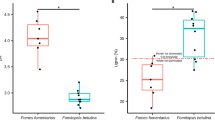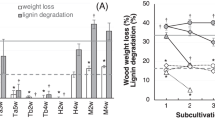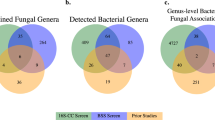Abstract
White-rot fungi are major degraders of woody materials in terrestrial environments because of their ability to decompose lignin. However, little is known on the possible associations of white-rot fungi with other microorganisms during wood decay. We investigated the numbers, community composition and functional traits of bacteria present in natural wood samples under advanced decay by the white-rot basidiomycete Hypholoma fasciculare. The wood samples contained high numbers of cultivable bacteria (0.2–8 × 109 colony forming units (CFU) per g of dry wood). Most cultivable bacteria belonged to Proteobacteria and Acidobacteria (75% and 23% of sequences, respectively). The same phyla were also found to be dominant (59% and 23%, respectively) using a non-culturable quantification technique, namely, direct cloning and sequencing of 16sRNA genes extracted from wood. Bacteria that could be subcultured consisted of acid-tolerant strains that seemed to rely on substrates released by lignocellulolytic enzyme activities of the fungus. There were no indications for antagonism (antibiosis) of the bacteria against the fungus.
Similar content being viewed by others
Log in or create a free account to read this content
Gain free access to this article, as well as selected content from this journal and more on nature.com
or
References
Bååth E . (2001). Estimation of fungal growth rates in soil using C-14-acetate incorporation into ergosterol. Soil Biol Biochem 33: 2011–2018.
Baldrian P . (2008). Enzymes of saptrotrophic basidiomycetes. In: Boddy L, Frankland JC, van West P (eds). Ecology of Saprotrophic Basidiomycetes. Academic Press: Amsterdam, pp 19–41.
Baldrian P, Valášková V . (2008). Degradation of cellulose by basidiomycetous fungi. FEMS Microbiol Rev 32: 501–521.
De Boer W, Folman LB, Summerbell RC, Boddy L . (2005). Living in a fungal world: impact of fungi on soil bacterial niche development. FEMS Microbiol Rev 29: 795–811.
De Boer W, van der Wal A . (2008). Interactions between saptrotrophic basidiomycete and bacteria. In: Boddy L, Frankland JC, van West P (eds). Ecology of Saprotrophic Basidiomycetes. Academic Press: Amsterdam, pp 143–153.
Folman LB, Klein Gunnewiek PJA, Boddy L, de Boer W . (2008). Impact of white-rot fungi on numbers and community composition of bacteria colonizing beech wood from forest soil. FEMS Microbiol Ecol 63: 181–191.
Hatakka A . (2001). Biodegradation of lignin. In: Hofrichter M, Steinbüchel A (eds). Lignin, Humic Substances and Coal. Wiley-VCH: Weinheim, pp 129–179.
Kirby R . (2006). Actinomycetes and lignin degradation. Adv Appl Microbiol 58: 125–168.
Martínez AT, Speranza M, Ruiz-Duenas FJ, Ferreira P, Camarero S, Guillén F et al. (2005). Biodegradation of lignocellulosics: microbial chemical, and enzymatic aspects of the fungal attack of lignin. Int Microbiol 8: 195–204.
Mikluscak MR, Dawson-Andoh BE . (2004). Microbial colonizers of freshly sawn yellow-poplar (Liriodendron tulipifera L.) lumber in two seasons: Part 2. Bacteria. Holzforschung 58: 182–188.
Murray AC, Woodward S . (2007). Temporal changes in functional diversity of culturable bacteria populations in Sitka spruce stumps. Forest Pathol 37: 217–235.
Tornberg K, Baath E, Olsson S . (2003). Fungal growth and effects of different wood decomposing fungi on the indigenous bacterial community of polluted and unpolluted soils. Biol Fertil Soils 37: 190–197.
Warmink JA, van Elsas JD . (2008). Selection of bacterial populations in the mycosphere of Laccaria proxima: is type III secretion involved? ISME J 2: 887–900.
Zhang HB, Yang MX, Tu R . (2008). Unexpectedly high bacterial diversity in decaying wood of a conifer as revealed by a molecular method. Int Biodeterior Biodegradation 62: 471–474.
Acknowledgements
This work was supported by the Ministry of Education, Youth and Sports of the Czech Republic (LC06066) and by the Institutional Research Concept No. AV0Z50200510 of the Institute of Microbiology of the ASCR, v.v.i. The Federation of European Microbiological Societies is acknowledged for a travel grant to Vendula Valášková. The authors also thank Dr Miroslav Kolařík for valuable discussion about data analysis.
Author information
Authors and Affiliations
Corresponding author
Additional information
Supplementary Information accompanies the paper on The ISME Journal website (http://www.nature.com/ismej)
Supplementary information
Rights and permissions
About this article
Cite this article
Valášková, V., de Boer, W., Klein Gunnewiek, P. et al. Phylogenetic composition and properties of bacteria coexisting with the fungus Hypholoma fasciculare in decaying wood. ISME J 3, 1218–1221 (2009). https://doi.org/10.1038/ismej.2009.64
Received:
Revised:
Accepted:
Published:
Issue date:
DOI: https://doi.org/10.1038/ismej.2009.64
Keywords
This article is cited by
-
Metagenomes, metatranscriptomes and microbiomes of naturally decomposing deadwood
Scientific Data (2021)
-
Soil Acidobacteria Strain AB23 Resistance to Oxidative Stress Through Production of Carotenoids
Microbial Ecology (2021)
-
Biodegradability of woody film produced by solvent volatilisation of Japanese Beech solution
Scientific Reports (2020)
-
Bacterial contributions to delignification and lignocellulose degradation in forest soils with metagenomic and quantitative stable isotope probing
The ISME Journal (2019)
-
Microbial succession on decomposing root litter in a drought-prone Scots pine forest
The ISME Journal (2019)



